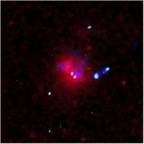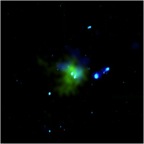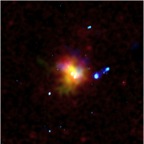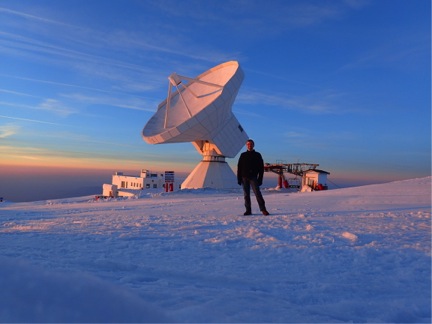News
A distant galaxy cluster merger
In the local universe, the largest gravitationally bound structures contain hundreds of thousands of galaxies. These galaxies lie along filaments surrounding and falling into massive galaxy clusters located at the intersections of this cosmic web. Because they contain galaxy clusters and their surrounding environments, these objects are known as superclusters. The formation of superclusters is ongoing, and their formation is a process that has taken most of the 13.8 billion years since the Big Bang. A recent example of a supercluster structure is the Lanaikea Supercluster, which contains our home – the Milky Way galaxy – as well as the nearby Virgo Cluster.
 |
 |
 |
| Figure 1: PLCK G147.3-16.6 in the XMM-Newton X-ray imaging (left, red) and GISMO SZ imaging (middle, green), and combined (right). The combined X-ray + SZ signal appears yellow in the RGB color scale. Each image is overlaid in blue with low-frequency radio emission probed by the Giant Metrewave Radio Telescope (GMRT), which probes the extremely disturbed, relativistic gas in this merging cluster. |
Beyond the local universe, as we look deeper into space, we see billions of years into the past since light from unfathomably large distances is just reaching us now. Looking back to over 3 billion years ago, the largest structures we find are not superclusters. Instead we see galaxy clusters, the most massive examples of which contain thousands of galaxies. Observations of the largest structures at any given time in the Universe allow us to map the 13.8 billion year history of structure formation, which tells us about the properties of the Universe itself. It was in clusters that we first discovered Dark Matter, a mysterious material that holds together the stars and gas we see in clusters and galaxies.
The Planck Satellite, built by the European Space Agency (ESA) with supporting instrument contributions by NASA, has recently mapped the entire sky, detecting over 1000 galaxy clusters through a distance-independent phenomenon called the Sunyaev-Zel’dovich (SZ) effect. Light from the Big Bang that is still reaching us today, known as the Cosmic Microwave Background (CMB), comes from all directions. As it passes through the hot gas in galaxy clusters, its spectrum is changed, leaving a “hole” in the background at the frequencies the Planck satellite used to detect them.
Of the previously unknown clusters that Planck found, a team of scientists using the Goddard-IRAM Superconducting 2-Millimeter Observer (GISMO) on the IRAM 30 meter telescope selected one spectacular candidate to image at 30 times higher resolution than Planck’s original detection. The GISMO SZ observational team includes Tony Mroczkowski (Naval Research Lab), Johannes Staguhn (JHU/NASA; head of the GISMO instrument team), Attila Kovács (Caltech), and Dominic Benford (NASA), with support in the data analysis from Esra Bulbul (Harvard), Tracy Clarke (Naval Research Laboratory), Reinout van Weeren (Harvard), Scott Randall (Harvard), and Huib Intema (National Radio Astronomical Observatory). The observations benefitted tremendously from scanning and noise tests performed by Israel Hermelo (IRAM) and the entire software and telescope support team. As with Planck, GISMO is a NASA-developed camera operating from a European platform. The result of their efforts is the first SZ image with GISMO on the IRAM 30-meter telescope.
The cluster they observed, called PLCK G147.3-16.6, was known from early X-ray follow-up observations with the ESA’s XMM-Newton telescope to be a merger of two smaller clusters. To the surprise of the scientists leading the GISMO observations, the ground based imaging took less than 1/3 the time of the space-based X-ray observations (see Figure 1, left) and reveal most of the same structure seen in the X-ray observations (see Figure 1, right).
Quoting GISMO lead Johannes Staguhn, “At first glance, I could not tell which was the X-ray and which was the SZ image. I am just amazed by the level of detail we see, and how quickly we see it!” IRAM support scientist Israel Hermelo added, “No one had ever tried such observations of distant clusters with GISMO before. I was surprised how quickly we could see it.”
 |
| Figure 2: GISMO SZ observation lead Tony Mroczkowski, standing (very far) in front of the IRAM 30 meter telescope in a rare break from observing galaxy clusters (March 2015). |
While in principle the XMM-Newton X-ray observations were 3 times higher resolution than the IRAM 30-meter observations, the X-ray signal is much weaker at greater distances, like all forms of astronomical emission. However, the SZ effect is not due to emission, and its strength does not diminish with distance – a property that is unique in astronomy and makes it well suited to studies of structure in the high-redshift, distant universe. The noise-dominated X-ray observation had to be carefully background subtracted and smoothed for display, and the spectral analysis to study the temperature in PLCK G147.3-16.6 required very careful modeling of the signal from particles bombarding the space-borne XMM-Newton observatory.
“The X-ray analysis of this faint high-redshift source has been extremely challenging, but worth it!” said Esra Bulbul, who led the analysis of the 16 hours of XMM-Newton X-ray follow-up of PLCK G147.3-16.6. Esra is no stranger to challenging X-ray analyses. Her analysis of the X-ray data on PLCK G147.3-16.6 follows her recent study combining XMM-Newton observations of 73 clusters, including one set of observations that spans 17 days of data on the Perseus Galaxy Cluster alone.
The team is delighted with the success of SZ observations using GISMO on the IRAM 30m telescope. "This is just the tip of the iceberg as we enter an exciting era, when high-resolution SZ measurements from the ground can provide comparable imaging to space-based X-ray observations. The GISMO and NIKA prototype continuum arrays at the 30m telescope have paved the way for the new large field-of-view NIKA-2 camera for the 30m, which shall be commissioned by end of 2015", said SZ project lead Tony Mroczkowski.
More information
Preprint of the original article RESOLVING THE MERGING PLANCK CLUSTER PLCK G147.3-16.6 WITH GISMO
Contact SZ project lead Tony Mroczkowski.



